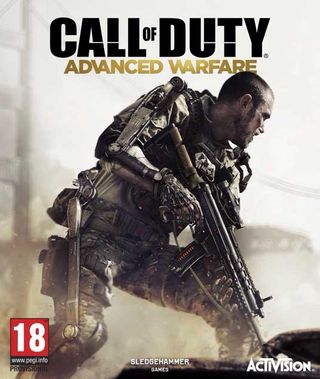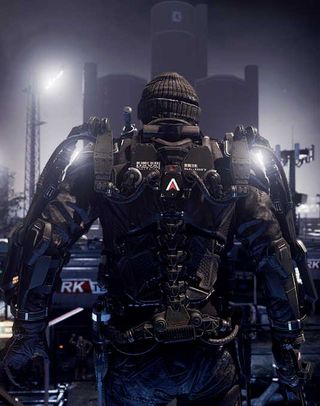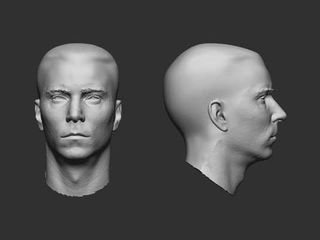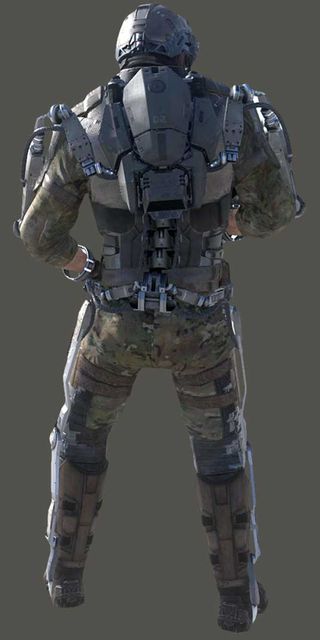
The latest in the insanely popular series of first-person shooter video games, Call of Duty: Advanced Warfare was released earlier this month. The eleventh installment in the series, it's the first to be developed primarily by Sledgehammer Games.
We caught up with Sledgehammer's CG supervisor Dave Blizard and director of animation Chris Stone to find out how it was put together...
What software did you use to create Call of Duty Advanced Warfare?
DB: We use many different commercial and proprietary software packages in our pipeline. This is generally dependent on the group or discipline. The character team for example may be spending 90 per cent of their time in Maya while the lighting and VFX teams are using mainly proprietary tools.
We strive to use the best tools for the job and not let pipeline or legacy get in our way. We have evolved the proprietary tools over many projects and we always look at this as a work in progress. We are never really done with our tools, we constantly strive to make them better over time.
What has been the biggest challenge for the new integration of CoD?
DB: I can speak best to the challenges of lighting and rendering. We made some major changes for Advanced Warfare that really caused us to rethink the way we work.
From the beginning we wanted to go for more of a documentary feel and move away from a painterly or fantastic look. The foundation of this was to change to a physically based shading and rendering paradigm along with using captured and physically correct skies.

This change required the artists to "trust" the system vs. "tuning by taste". The great thing about working in this way is that we can use tools to measure light readings in the real world and compare those to the values we are achieving via the game engine. We now have an actual baseline to compare against to ensure physically accuracy.
What performance capture setup did you use to capture Kevin Spacey?
CS: We used a combination of cutting edge motion capture processes to achieve the lifelike performances of Kevin Spacey. On the physical 'body' side of the capture (not the face) we used the largest standard body motion capture stage available to help achieve scenes on a grand scale without the need to marry multiple scenes captured.
The traditional mocap stage featured hundreds of Mocap cameras capturing 120 frames of body animation per character per second of capture. With that approach, it allowed us to have twice as much motion data as would technically be needed to run in our game engine at 60 frames per second, however it allowed us to have a far greater “resolution” when it came to capture data.
And the face?
CS: On the facial side of the capture, we used a new High definition head mounted camera system (HMC). These head mounted cameras were individually fitted and calibrated for the unique shapes and expressions for each of our talent.
Once fitted they provided a fixed, un-occluded view of the face which allowed us to observe the luminescent paint “dots” as they corresponded to the facial expression each of our talent would display in the performance. This gave us the best possible way to analyse and recreate the perfect expressions and likenesses of each of our characters in game.
Another big technology achievement in our PCAP process was the use of “virtual stages” on the sets. This means that as each of our mocap talent performed on the mocap stage, they could see themselves interacting in a virtual world with the other characters, with their props, in the actual digital environment that we use for the game.
This allowed a far better performance from the entire cast as no longer were they acting against “imaginary” elements in some “unknown” setting. Is was more as if they were acting on a physical set with the scene playing out around them.
What can the rest of the CG industry learn from the games industry, right now?
DB: We actually took quite a bit from film and non real-time rendering for the basis of our physically based system. Of course since we are dealing with rendering in Milliseconds we have to make some assumptions in regards to simplifying some shading models. Regarding what CG can learn from games? I'd say it's to appreciate the fact that we have to render 60 frames per second in real-time!

We have implemented various CPU and GPU based rendering acceleration techniques that could be used to help with a real-time previewing interface to work and light in a more interactive way.
Moving towards a more of a "practical lighting approach" would be my focus. Working in a way that people who light for motion pictures, photography or stage work. It's much more of a dynamic and fluid process, vs something that is so fragmented.
What advice can you give an artist wanting to break into gaming?
DB: I always encourage people to explore and have fun. They have access to so many free and online tools that never existed before. When I was getting involved in the industry I didn't have this luxury. You can use these to make your own games and your own content.
Explore and research and become a DIY gamer. This will provide a great foundation for getting involved in a larger game and bigger teams. There should be nothing to stop you from moving forward and finding out what you really like to do. What part of the game building process do you like the most. Figure this out and then don't stop until you have achieved your goals.
What skills or experience are needed to be a games artist?
DB: There are many elements that come together to make a successful games artist but I would say the thing that trumps them all is passion. Someone said. "If you do what you love you will never work a day in your life."
Being a game developer requires a significant amount of work, effort and dedication. It's the combination of all of these things along with a natural talent that culminates in someone who is a highly skilled and respected artist. Be humble and just do amazing work.
Where do you see game CG going in the next 5 years?
DB: This is such a fast and exciting field to be in and I can't wait to see where things are in another five years. There is a bunch of research happening in realtime raytracing and also browser-based cloud rendering that may change the way we play games in the future.

I also like the idea of integrating games that can play continually across many devices in various ways. With each new evolution of console we are doing more complex rendering and shading which is a great place for us to be as lighting and rendering artists.
Can you tell us about the art and direction of the game?
DB: Early on when we started to discuss things, Joe Salud, the Art Director, and myself discussed the look and feel of the game. We wanted it to be different and more documentary style. We really liked the look of District Nine and Hurt Locker along with a few other films. We wanted to embrace the imperfections of reality and shoot skies that were real.
Sometimes when you shoot a sky it can be plain without much visual interest, but this is what happens when you make a live action film. Unless you want to paint out the sky, you need to use what you shoot. We decided to use skies like this without pushing the bounds and breaking the physical correctness by creating elaborate dramatic skybox paintings which become too surreal.
This also provided a great foundation for the rest of the scene to be built upon. It really had us doing a double take a few times when you see a monitor from across the room you think. "Is that a photograph?" If an image could pass this "squint test" we knew we were on the right track.
The other component that we relied upon was using a LA based color grading company and artist. Basically a post process pipeline was introduced to the game development process. They colour corrected our entire game and used Hollywood film making techniques to give us a polished visual identity.
What's your advice on landing a dream job in the games industry?
- Be passionate about what you do
- Have a personality that makes others want to be around you.
- Never give up in the pursuit of knowledge.
- Get your foot in the door somehow and then do your best work.
- The quality of your work should be based on your own standards of excellence.

Thank you for reading 5 articles this month* Join now for unlimited access
Enjoy your first month for just £1 / $1 / €1
*Read 5 free articles per month without a subscription

Join now for unlimited access
Try first month for just £1 / $1 / €1
Get the Creative Bloq Newsletter
Daily design news, reviews, how-tos and more, as picked by the editors.

Tom May is an award-winning journalist and editor specialising in design, photography and technology. Author of the Amazon #1 bestseller Great TED Talks: Creativity, published by Pavilion Books, Tom was previously editor of Professional Photography magazine, associate editor at Creative Bloq, and deputy editor at net magazine. Today, he is a regular contributor to Creative Bloq and its sister sites Digital Camera World, T3.com and Tech Radar. He also writes for Creative Boom and works on content marketing projects.